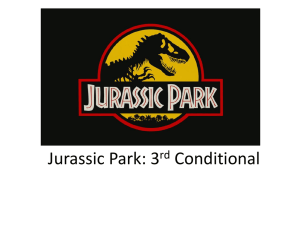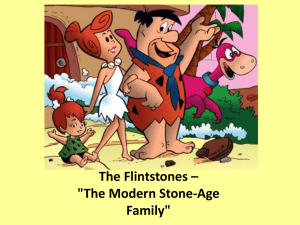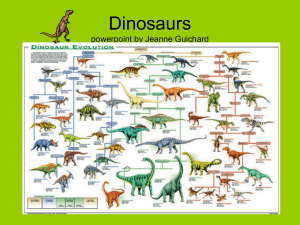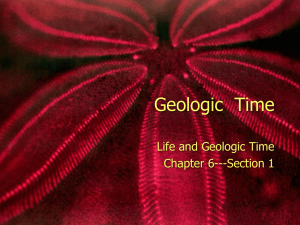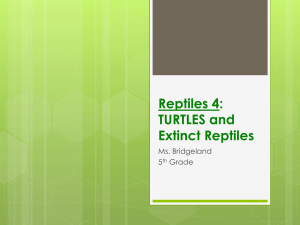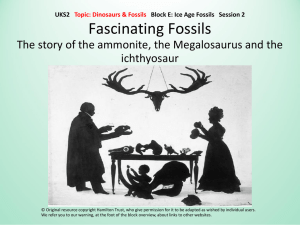Wynne_haupt
advertisement
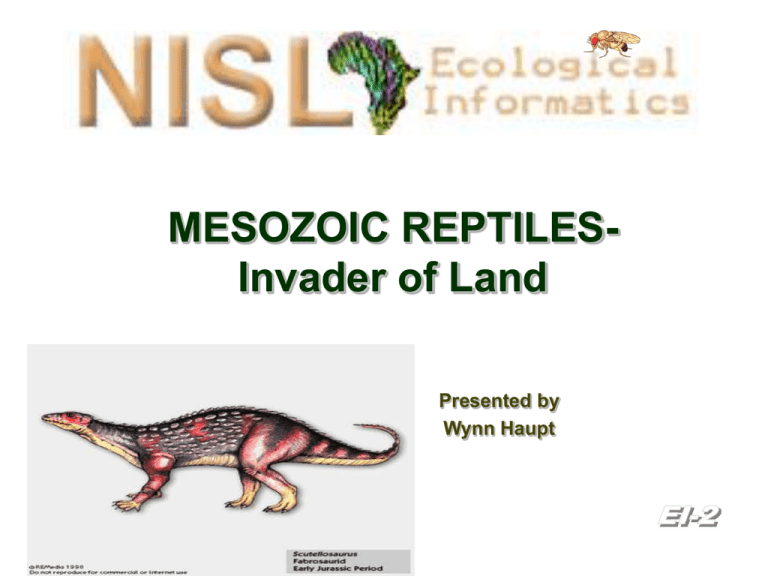
MESOZOIC REPTILESInvader of Land Presented by Wynn Haupt Contents 1. 2. 3. 4. 5. 6. 7. 8. 9. 10. 11. 12. 13. 14. Intoduction Mesozoic Reptile Classification Defining the Mesozoic Era Common Ancestor (Thecodonts to Dinosaurs) Order Saurischia Suborder Theropoda Characteristic features Suborder Theropoda Unique Characteristic features Order Ornithischia Suborder Ornithopoda Suborder Ornithopoda Suborder Stegosauria Suborder Ankylosauria Suborder Ceratopsia Reference List Introduction In this presentation I will discuss the diversity of the land dwelling reptiles of the Mesozoic era. I will show how they are unique and what makes them unique. Basically land dwelling dinosaurs evolved from a common ancestor and divided into two orders based on their pelvic structures. Mesozoic Reptile Classification Kingdom – Animalia Phylum – Chordata Class – Reptilia Subclass – Diapsida Super order – Archosauria Order – Saurischia Ornithischia Defining the Mesozoic Era The Mesozoic era was about 248-65Million Years Ago. The Mesozoic era is divided into three periods, Triassic 245 - 208 MYA, Jurassic 208 -146 MYA, and the Cretaceous 146 - 65 MYA. Mesozoic means "middle animals" this was the time when most modern plants, invertebrates and fish started evolved. The land was dominated by Mesozoic reptiles, the ocean dominated by large marine reptiles and the air ruled by Pterosaurs. Warm and tropical climate at the time was mostly experienced. Mesozoic era was around when, all the worlds’ continents were joined to form the supercontinent called Pangea. (www.palaeos.com/mesozoic/mesozoic.htm) Defining the Mesozoic Era Cont. Mesozoic reptiles invaded the land water and ocean. The fossil records tell use the story of the Mesozoic era. Fossils are the mineralized remains of animals and plants or the trace such as footprints. The totality of fossils is their place in rock formation and the sedimentary layers is known as the fossil records. (www.en.wikipedia/org/wiki/fossils) Common Ancestor (Thecodonts to Dinosaurs) Dinosaurs evolved from a group of socket toothed reptiles the thecodonts, which appeared about 225 million years ago (Lambert, 1983). Early thecodonts were sprawling, crocodile-like called proterosuchians (“earlier crocodile”) (Lambert, 1983). Many thecodonts bodies where equipped them for hunting life spent mostly in the water (Lambert, 1983). They swam using their long, deep tails, but their hind limbs gave them their powerful forward thrust, their hind limbs where longer and stronger than there forelimbs (Lambert, 1983). Thecodonts that went to live on land could thrust theirwhole limbs down and back, giving them a longer stride than other reptiles of their size (Lambert, 1983). Thecodonts divided into two main groups the saurischian and ornithischian dinosaurs. Common Ancestor (Thecodonts to Dinosaurs) Cont. Most could walk upright like a dog and raised their bodies off the ground (Lambert, 1983). Pseudosuchian (sham crocodiles) thecodonts walked on all fours, but short front legs made running difficult, so they sprinted on their long hind legs and balanced with their long, strong tail (Lambert, 1983). In time there were many sizes of these flesh-eating pseudosuchians, the thecodont speed could of help with their rise in abudance (Lambert, 1983). By 205 million years ago pseudosuchians gave rise to the first flesh eating dinosaur (Lambert, 1983). Soon there were large and small dinosaurs, including those with teeth designed to eat leaves (Lambert, 1983). By 193 million years ago, flesh eating dinosaurs replaced thecodonts, and nearly all big herbivores were dinosaurs (Lambert, 1983). Source Unkown Order Saurischia One of two distinct orders of dinosaur, distinguished from each other by differences in structure (Microsoft Encarta 98). Saurischian (lizard-hipped) dinosaurs had a pelvic structure similar to that of extant (surviving) reptiles (Microsoft Encarta 98). Its hip girdle has three main bones, the pubis (front bone) faces forward in most saurichia (Lambert, 1983). They had teeth around the entire jaw, or only at the front, and included both carnivores (meat-eaters) and herbivores (plant-eaters) (Microsoft Encarta 98). The two main saurischia suborders evolved, the two legged, flesh eating theropods and the four legged, mostly plant eating sauropodomorphs (Lambert, 1983). Saurischians thrived all three periods of the Mesozoic Era, but as the age of the dinosaurs came to an end saurischians were outnumbered by the other major group of dinosaurs: the ornithischians (Lambert, 1983). Source unknown Suborder Theropoda Characteristic features Theropods fall under the order saurischia. Theropods have a reduced or the complete loss, of the outer finger of the hand (Farlow & Brett-Surman, 1997). They are flesh eaters, most have lade like teeth, which are serrated (Farlow & Brett-Surman, 1997). Claws are often recurved and taper to sharp points especially on the hand (Farlow & Brett-Surman, 1997). Theropods are slender, long legged, bipedal animals that are built to move quickly (Farlow & Brett-Surman, 1997). These characteristics are not unique to theropods, even though they are significant aspects of their appearance (Farlow & Brett-Surman, 1997). Suborder Theropoda Unique Characteristic features But uniquely theropods always have hollow limb bonesand also have a tendency towards air-filled bones in the front of its body (Farlow & Brett-Surman, 1997). Bone in front of eye extends onto the top of skull (Farlow & BrettSurman, 1997). Extra joint in lower jaw (Farlow & Brett-Surman, 1997) Elongated prezygapophyses found on tail (Farlow & Brett-Surman, 1997). Scapula is strap-like (Farlow & Brett-Surman, 1997). Hand is elongated with loss of outer finger (Farlow & Brett-Surman, 1997). Expansion on the distal end of pubis (Farlow & Brett-Surman, 1997). These are some of the unique characteristics of theropods. Order Ornithischia The other distinct order of dinosaurs are, distinguished from each other by differences in structure (Microsoft Encarta 98). Ornithischian (bird-hipped) dinosaurs had forward and backward projecting extensions to the pubic bone of the pelvis, superficially resembling the pelvic structure of a bird (Microsoft Encarta 98). The front of the jaws developed into a horny beak, with powerful grinding teeth, cheek pouches and lattice of bony tendons reinforcing the spine (Lambert, 1983). . All known ornithischians were herbivores (plant-eaters) (Microsoft Encarta 98). They also had an extra bone forming the tip of the lower jaw (Lambert, 1983). They were two legged, four legged plated, horned and armored dinosaurs (Lambert, 1983). The four suborders which fall under the order of ornithischian dinosaurs. Source unknown Suborder Ornithopoda Only ornithopods that were able to walk or run on their hind legs (Lambert, 1983). “bird-footed” bird-hipped bipeds were dinosaur equivalents of browsing mammals like deer and gazelles (Lambert, 1983). They were herbivorous, existed from the earliest Jurassic to the end of the Cretaceous period and were the first herbivores to have multiple tooth rows cheek pouches, true mastication and the first to engage in selective feeding (Farlow & Brett-Surman, 1997). They lacked horns and armor (Farlow & Brett-Surman, 1997). Walk on their toes, have five functional fingers on the hand and three on its foot, the pre-pubic bone projects forward and away from the midline of the body (in contrast to theropods) (Farlow & BrettSurman, 1997). Considered to be the stem group of the order due to its lack of horns, armor and spikes (Farlow & Brett-Surman, 1997). Suborder Ornithopoda cont. Ornithopods are diagnosed as follows: premaxillary teeth are on a lower level than the maxillary teeth, jaw joints lower than tooth rows so jaw comes together like nutcrackers, the premaxillary bone has a process that extends backward towards the orbit, and there is a large fourth trochanter on the femur for the attachment of the caudifemoralis muscle group (Farlow & Brett-Surman, 1997). Suborder Stegosauria Known as the plated dinosaur (Lambert, 1983). Bony spikes or plates, or both, which are embedded into its thick skin, it guarded the neck, back, and tail and could have been used for to shed unwanted body heat (Lambert, 1983). They walked on all fours unless they browsed on trees then it would stand on its rear legs (Lambert, 1983). They could only feed on soft lush plants because of short, weak teeth (Lambert, 1983). Under attack they might have swung its spiky tail, but their flanks would become vulnerable (Lambert, 1983). Suborder Ankylosauria Ankylosaurs (fused lizzards) were short limbed, four legged, armor plated dinosaurs with long wide body (Farlow & Brett-Surman, 1997). Most prominent armor, or scutes consisted of keeled or unkeeled plates of bone embedded into the skin of the dinosaur (Farlow & Brett-Surman, 1997). This armor protect exposed part of the body (Lambert, 1983). The scutes were sometime repaced by spines or spikes on the body and tail (Farlow & Brett-Surman, 1997). In at least one group you would find a bone club at the end of its tail (Farlow & Brett-Surman, 1997). They had weak jaws and small teeth, which meant they ate soft, low growing plants, but might live on insects (Lambert, 1983). Suborder Ceratopsia Known as horned dinosaurs were one of the last to evolve (Lambert, 1983). They were the largest and most abundant group of dinosaurs (Lambert, 1983). Mostly four legged, with massive heads armed with formidable horns (Lambert, 1983). They had a bony frill jutting backward from the skull which masked the neck and provided an anchor for powerful muscles that worked jaw ending in a massive “parrot’s beak” (Lambert, 1983). Browsed on tough leaved plants and used its horn to ward off attacks by carnivores (Lambert, 1983). In modern time they could be categorized as rhinoceroses or cattle (Lambert, 1983) Reference List Brett-Surman. M and Farlow. J, The Complete Dinosaur, (1997), Indiana University Press, Bloomington and Indanapolis Lambert. D, A Field Guide to Dinosaurs,(1983), Avon Books, New York (www.palaeos.com/mesozoic/mesozoic.htm) (www.en.wikipedia/org/wiki/fossils)


